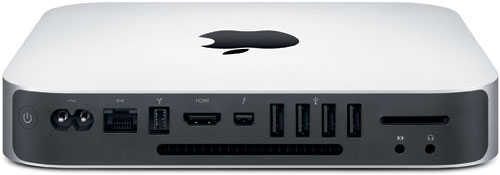External Gpu For Mac Mini 2011

- Best Mac External Gpu
- External Gpu For Mac Mini
- External Gpu For Mac Mini 2020
- External Gpu For Mac Mini 2011 Video
- External Nvidia Gpu For Mac
Created in close collaboration with Apple, Blackmagic Design's Blackmagic eGPU and Blackmagic eGPU Pro bring accelerated pro app workflows, smoother gameplay, and true-to-life VR content creation to your Mac.
Best Mac External Gpu
Technical specifications

Blackmagic eGPU includes a Radeon Pro 580 graphics processor with 8GB DDR5 memory, giving your connected Mac graphics performance that's similar to a high-end 27-inch iMac.
- I have a Mac Mini mid 2011 and installed Windows 10 fine on it, even updated to the latest Fall Creators Update with no problems. Initially I had laggy movements with the Magic Mouse but I use a wired mouse now. I used the Windows 8.1 drivers and Bootcamp 5 drivers I think. I let Bootcamp setup the partition and USB drive.
- 【Mac】Mac miniにeGPUを導入した経緯、選び方、実際どうだったか【Radeon RX Vega 64】 - Duration: 11:21. 池上幸太朗・音楽クリエイター 2,374 views 11:21.
Blackmagic eGPU Pro includes a Radeon RX Vega 56 graphics processor with 8GB HBM2 memory. This gives your connected Mac graphics performance that's similar to iMac Pro.
In addition to boosting graphics performance, both Blackmagic eGPUs provide 85 watts of charging power to MacBook Air and MacBook Pro.
Blackmagic eGPU has these ports to connect displays and VR accessories:
- Two Thunderbolt 3 (USB-C)
- Four USB 3.0
- One HDMI 2.0
Using an external graphics card (eGPU) is the best way to boost your Mac’s graphics performance. And, of course, a model like the Mac mini will need you to provide an external display anyway. However, with Mac models featuring Thunderbolt you can attach an external GPU. We have a tutorial on adding an eGPU to a Mac here. 2011 Mac mini: RAM, Hard drive, Logic board, fan, etc. Get desktop-class graphics performance on your MacBook Pro with the Blackmagic eGPU. Featuring the Radeon Pro 580 graphics processor, the Blackmagic eGPU is built to make any Mac with Thunderbolt 3 ports a graphics powerhouse. Enjoy supersmooth gaming, accelerate graphics-intensive pro app workflows, and enable VR experiences or content creation.
Blackmagic eGPU Pro has these ports:
- Two Thunderbolt 3 (USB-C)
- Four USB 3.0
- One HDMI 2.0
- One DisplayPort 1.4
System requirements
Blackmagic eGPU is compatible with any Thunderbolt 3-equipped Mac running macOS High Sierra 10.13.5 or later. Blackmagic eGPU Pro requires a Thunderbolt 3-equipped Mac and macOS Mojave 10.14.1 or later.
If you have a Mac mini (2018) or Mac Pro (2019) with FileVault turned on, make sure to connect your primary display directly to your computer during startup. After you log in and see the macOS desktop, you can unplug the display from your computer and connect it to Blackmagic eGPU.
To connect Apple Pro Display XDR to Blackmagic eGPU or Blackmagic eGPU Pro, make sure your Mac is running macOS Catalina 10.15.2 and your eGPU has the latest firmware.
Here's how to update the firmware of your eGPU:
- Go to the Blackmagic website.
- Select the DaVinci Resolve, Fusion, and BlackMagic eGPU product family.
- Download and install the latest firmware for your eGPU.
Connect and use Blackmagic eGPU
When you connect Blackmagic eGPU or Blackmagic eGPU Pro to your Mac with a Thunderbolt 3 (USB-C) cable, the eGPU menu bar item appears, indicating that the eGPU is ready for use.
Blackmagic eGPU automatically accelerates the graphics from Metal-based apps on external displays and devices that are connected to the eGPU. You can use Activity Monitor to confirm that your eGPU is in use:
- Open Activity Monitor, which is in the Utilities folder inside Applications.
- Choose Window > GPU History. A graph appears, charting the activity of your computer's internal GPU and Blackmagic eGPU.
To disconnect Blackmagic eGPU, use the menu bar item to safely disconnect the eGPU from your Mac before unplugging the cable.
Use the 'Prefer external GPU' option
Starting with macOS Mojave 10.14, you can turn on 'Prefer external GPU' in a specific app's Get Info panel in the Finder. This option lets Blackmagic eGPU and Blackmagic eGPU Pro accelerate apps on any display connected to the Mac — including displays built in to the Mac:
- Quit the app if it's open.
- Select the app in the Finder. Most apps are in your Applications folder. If you open the app from an alias or launcher, Control-click the app's icon and choose Show Original from the pop-up menu. Then select the original app.
- Press Command-I to show the app's info window.
- Select the checkbox next to Prefer external GPU.
- Open the app to use it with the eGPU.
Learn more about using eGPUs with your Mac.
Learn more
macOS currently doesn't support eGPUs in Windows using Boot Camp or when your Mac is in macOS Recovery, at FileVault login, or installing system updates.
There is some yes and no here. At least in the case of
External Gpu For Mac Mini
2011 Minis, some of the new Thunderbolt->PCI-X card
boxes can nearly fully support any PCI-X video card,
if running Windows7 via Bootcamp. In OSX however,
a Thunderbolt aware driver for the video card is required.
So, this would also be true for the 2012 as it is an OSX
limitation and not hardware.
There are Thunderbolt->Express Card adapters (Sonnet
is main source). They seem to be limitied as to which
Express Cards are usable. Again, it seems to be a
External Gpu For Mac Mini 2020
driver issue.
External Gpu For Mac Mini 2011 Video
So as yet, external GPUs seem to be accessible only via
these pricey Thunderbolt->PCI-X boxes with Windows
(using Bootcamp install) and not OSX.
External Nvidia Gpu For Mac
Nov 9, 2012 11:23 AM